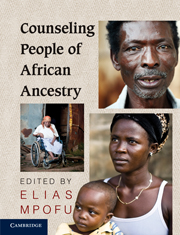Book contents
- Frontmatter
- Contents
- Contributors
- About the Editor
- Editorial Board
- Foreword
- Preface
- Acknowledgments
- PART 1 FOUNDATIONS OF COUNSELING IN AFRICAN SETTINGS
- PART 2 CONTEXTS OF COUNSELING
- 7 School Counseling
- 8 Counseling Students at Tertiary Institutions
- 9 Family Therapy within the African Context
- 10 Pastoral Care and Counseling
- 11 African Refugees: Challenges and Prospects of Resettlement Programs
- 12 Counseling Orphans and Vulnerable Children in Africa
- 13 Diversity Counseling with African Americans
- 14 Resolving Conflict in Africa: In Search of Sustainable Peace
- PART 3 COUNSELING APPLICATIONS
- PART 4 THE FUTURE OF COUNSELING IN AFRICAN HERITAGE SETTINGS
- Counseling People of African Ancestry Multiple Choice Answers
- Index
12 - Counseling Orphans and Vulnerable Children in Africa
Published online by Cambridge University Press: 05 August 2011
- Frontmatter
- Contents
- Contributors
- About the Editor
- Editorial Board
- Foreword
- Preface
- Acknowledgments
- PART 1 FOUNDATIONS OF COUNSELING IN AFRICAN SETTINGS
- PART 2 CONTEXTS OF COUNSELING
- 7 School Counseling
- 8 Counseling Students at Tertiary Institutions
- 9 Family Therapy within the African Context
- 10 Pastoral Care and Counseling
- 11 African Refugees: Challenges and Prospects of Resettlement Programs
- 12 Counseling Orphans and Vulnerable Children in Africa
- 13 Diversity Counseling with African Americans
- 14 Resolving Conflict in Africa: In Search of Sustainable Peace
- PART 3 COUNSELING APPLICATIONS
- PART 4 THE FUTURE OF COUNSELING IN AFRICAN HERITAGE SETTINGS
- Counseling People of African Ancestry Multiple Choice Answers
- Index
Summary
OVERVIEW. Africa has the greatest proportion of orphans globally, with the HIV and AIDS pandemic one of the foremost reasons for this situation (UNAIDS/UNICEF/USAID, 2004). Despite the high numbers of orphans and other vulnerable children on the continent, state and federal governments repeatedly consider these children a last priority in social service provision. Furthermore, many services addressed toward these children attend to their basic needs and seldom address their emotional well-being. In this chapter, the psychological experiences of orphans and other vulnerable children are explored and counseling techniques that can be applied to this population group discussed. Examples of current programs in Africa are also presented.
LEARNING OBJECTIVES
By the end of the chapter, the reader should be able to:
Outline the challenges of defining orphans and vulnerable children (OVCs) in an African context.
Explain the importance of providing counseling to OVCs, especially within the framework of children's rights.
Evaluate the role of HIV and AIDS in the psychosocial experiences and well-being of OVCs.
Discuss appropriate counseling supports for OVCs.
Describe areas requiring further research in the counseling of OVCs.
INTRODUCTION
Statistics paint a poignant picture of the landscape of OVCs in Africa. According to the Children on the Brink Report (UNAIDS/UNICEF/USAID, 2004), in 2003, approximately 43 million orphans resided in sub-Saharan Africa. Of these children, roughly 11 million have become orphans as a result of the HIV and AIDS pandemic (UNAIDS, 2008).
- Type
- Chapter
- Information
- Counseling People of African Ancestry , pp. 180 - 192Publisher: Cambridge University PressPrint publication year: 2011

